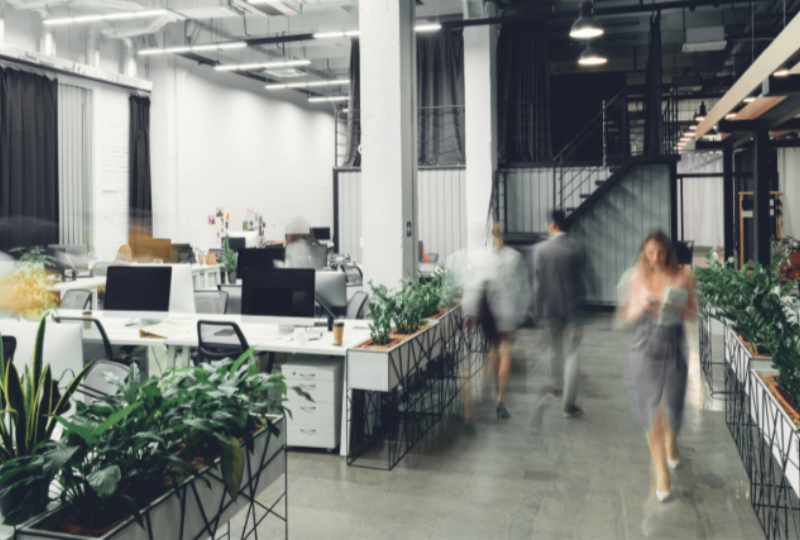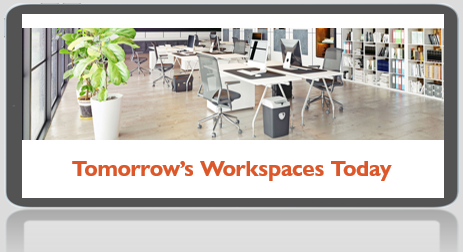Five Trends to Integrate into your Workplace in 2024
The office as a physical (and digital) space is continuing to transform with changes in working practices, hybrid working, and an emphasis on sustainability. What are five ways to stay ahead of the curve, retaining employees and attracting new talent in the process?
With the average worker spending 90,000 hours at work in their lifetime, it is widely understood that creating an environment that fosters satisfaction and happiness pays dividends not just for staff, but for your organization’s productivity too.
From cutting-edge technologies to new ways of working and collaborating, this piece explores the trends that will shape the workplace throughout 2024 and beyond.
A Slow Return to the Office
The ongoing prevalence of hybrid working has meant the five-day office commute is increasingly less common, evidenced by Microsoft Teams calls and meetings increasing 1000% since the pandemic. With the vast number of benefits – commute times slashed, better work-life balance, not to mention less load on public transport – it’s little wonder why remote working is something people increasingly look for in prospective employers.
While it’s a trend, it’s not universal though. Some organizations have already begun “encouraging” mandatory returns, with Google factoring in office attendance into their employee reviews and Goldman Sachs ending their ‘Summer Fridays’ in August 2023.
Andrew Fullerton Smith, General Manager of Sales in New Zealand for Crown Worldwide says this drive to reduce remote working is “driven mainly by employees looking for the social interaction and collaboration that is more effective in person.” Collaboration ideally helps to create a strong company culture, which is estimated to account for more than 30% of a company’s market value.
Employers must now think creatively about the working model they wish to implement and what purpose the office serves, consequently making necessary changes to the environment. A return to the office means first and foremost consideration of space: is the size suitable for the forecast increased numbers? Does the office need more workstations, space optimization, and so on? Alternatively, would a scheduling or hot-desking system work best to avoid claustrophobia in the workplace?
An Employee-Centric Workplace
The term “employee-centric” at first glance may seem like jargon, but proper definitions allude to profound and meaningful differences for employees in the workplace. Open offices, for example, have surprisingly demonstrated significant barriers regarding collaboration and communication, especially when incorporated with technology. Therefore, designing the office a space with employees in mind is a great opportunity to explore.
An employee-centric environment presents itself as an atmosphere driven by positivity and support, and a traditional benefits and rewards scheme is certain to deliver this. Recognition not only compliments top talent but can generate motivation, boost productivity and teamwork, as well as improve workplace culture. Rewards must be delivered appropriately – these should be genuine rewards presented to recognize outstanding employee performance and value alignment with the company vision.
Jamie Rossall, Country Manager, Vietnam, says ”there are still lots of people working from home. Many are reluctant to return full-time as they’ve become used to not having to commute. Do we want to bring these people back, and if so, how are we going to do it?”
Facilitating a flexible working policy promotes healthy work-life balance among employees, meaning hybrid meeting rooms remain king. Businesses are similarly investing in physical well-being: on-site gyms, yoga rooms, and canteen areas, and also providing mental health resources and medical professionals.
To win employees back into the office, introduce aspects like the ones above, depending on what your employees need. Whether that be via collaboration areas to encourage cooperation, suitable parking, access to appropriate transportation links, or simple a space to get away from screens. However, if continuing with a flexible working model, confirm that there is still an effective way to monitor performance.
Bringing the Outside, Inside
The significance of spending time in green spaces is well understood: reduced stress levels, connecting with the local community, and an improved mood. It comes as no surprise that offices are beginning to incorporate “biophilic” designs into their office spaces.
The presence of plants and green features in the workplace has been shown to enhance team productivity, mental well-being, and overall happiness. But it’s not just the psychological benefits that are leading businesses to incorporate natural elements within their spaces, as studies have shown that air quality is dramatically employed by the presence of even a few plants,
There are also commercial benefits to incorporating biophilic features, including aiding creativity due to the calming effect biophilia can have, as well as noise reduction due to the leaves, branches and stems absorbing and refracting sound.
Think about how you can build an office with biophilic features. Green, leafy feature walls, plants around the office, natural light sources, and indoor water features all help achieve this. Natural art can also help complement this.
A Circular Economy: Just Like New
Sustainable business practices start with a sustainable workplace. Electric vehicles, LED lighting, and renewable energy sources help immensely, but what about the furniture or technology we use once we’re there?
Modular furniture should be seen as an investment. For example, incorporating collaboration spaces with shutters to enable staff to take private calls, or interchangeable sofa sets that can be rearranged depending on the desired use. This adaptability can provide longevity while also reducing the need waste and further costs.
However, when the time comes to discard or replace office assets, nothing should go to waste. This is the basic philosophy of the circular economy: “Use less, share more”, and ensure that what you use has the potential to be reused, repurposed, or recycled. Sustainable practices demonstrate an active approach to tackling climate change whilst continuing to meet client and employee demands, maintain high productivity levels and potentially reduce costs.
Crown Workspace offers recycling and disposal services to help support businesses in meeting their legal and environmental commitments when disposing of IT hardware. IT equipment is securely destroyed to ensure critical data does not fall into the wrong hands.
Find out more about how Crown Workspace can help you with recycling and disposal by speaking with one of our experts.
Generative AI
Artificial Intelligence (AI) isn’t unheard of within office environments, but recent developments with generative AI have offered many more potential applications within the office.
Firstly, AI can be implemented before a colleague sets foot into an organization – its learning abilities and analytical software can aid with talent acquisition by filtering suitable candidates based on their resumes and relevant qualifications. LinkedIn Recruiter is just one such example.
In terms of office management, AI can be used in a range of tasks including implementing a room and desk-booking system or providing virtual meeting summaries and processed recordings. Both the scope and intensity of these applications are intensifying, as evidenced by Deloitte’s 2023 Global Human Capital Trends Report suggesting artificial intelligence and machine learning will contribute to a 37% increase in labour productivity by 2025.
AI technologies can also manage day-to-day office tasks,. AI sensors can identify when and where utilities are required, help monitor resources to reduce waste, as well as support sustainability initiatives. Businesses can also look at creating a safer working environment, with developments into hazard detection, surveillance, and head-counting in the event of an emergency.
In 2024, businesses seem to be mostly in the cost-benefit analysis stage of assessing AI technologies. It has admittedly come a long way, but given the concerns around factual reliability and absence of true creativity, AI should not be seen as a replacement for human efforts even in the office management space.
Summary
The changes of working practices brought about by the pandemic have, in many ways, forced us all to consider a range of opportunities and challenges for businesses. To stay ahead of the curve, organizations must continue to embrace cutting-edge technologies and prioritize employee well-being and satisfaction.
By creating an employee-centric environment, incorporating natural elements, and facilitating flexible working policies, organizations can promote collaboration, productivity, and happiness, ultimately leading to greater success and market value. As we step into the future, it’s essential for organizations to keep up with the latest trends and adapt accordingly to foster a dynamic and thriving workplace environment.
Want to embrace upcoming workplace trends in 2024? Crown Workspace can help – be sure to speak to our experts today.
Related stories
Whether it be storage for a relocation, security, safety, or even decluttering to create space, ensure you’re asking the right questions about your commercial storage.
Discover how Crown Worldwide Group is reducing carbon emissions by powering its UAE vehicle fleet with locally sourced biofuels. Learn about the partnership with Neutral Fuels and the positive impact on sustainability.
Unlock the potential of your workspace with Crown Workspace UAE. Discover innovative solutions to optimize office space, boost productivity, and save costs. Let us tailor a dynamic environment that empowers your team and drives success.

























